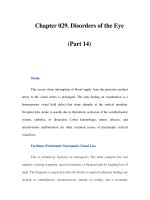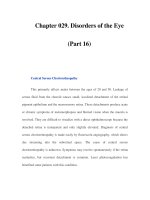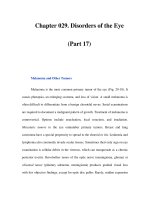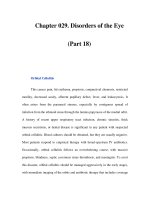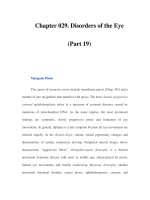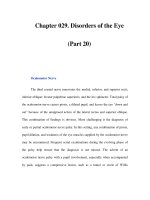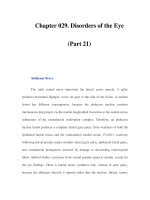Chapter 085. Neoplasms of the Lung (Part 6) doc
Bạn đang xem bản rút gọn của tài liệu. Xem và tải ngay bản đầy đủ của tài liệu tại đây (14.47 KB, 5 trang )
Chapter 085. Neoplasms of the Lung
(Part 6)
Diagnosis and Staging
Screening
Most patients with lung cancer present with advanced disease, raising the
question of whether screening would detect these tumors at an earlier stage when
they are theoretically more curable. The role of screening high-risk patients (for
example current or former smokers >50 years of age) for early stage lung cancers
is debated. Results from five randomized screening studies in the 1980s of chest x-
rays with or without cytologic analysis of sputum did not show any impact on lung
cancer–specific mortality from screening high-risk patients, although earlier-stage
cancers were detected in the screened groups. These studies have been criticized
for their design and statistical analyses, but they led to current recommendations
not to use these tools to screen for lung cancer. However, low-dose, noncontrast,
thin-slice, helical, or spiral CT has emerged as a possible new tool for lung cancer
screening. Spiral CT is a scan in which only the pulmonary parenchyma is
examined, thus negating the use of intravenous contrast and the necessity of a
physician being present at the exam. The scan can usually be done quickly (within
one breath) and involves low doses of radiation. In a nonrandomized study of
current and former smokers from the Early Lung Cancer Action Project (ELCAP),
low-dose CT was shown to be more sensitive than chest x-ray for detecting lung
nodules and lung cancer in early stages. Survival from date of diagnosis is also
long (10-year survival predicted to be 92% in screening-detected stage I NSCLC
patients). Other nonrandomized CT screening studies of asymptomatic current or
former smokers also found that early lung cancer cases were diagnosed more often
with CT screening than predicted by standard incidence data. However, no decline
in the number of advanced lung cancer cases or deaths from lung cancer was noted
in the screened group. Thus, spiral CT appears to diagnose more lung cancer
without improving lung cancer mortality. Concerns include the influence of lead-
time bias, length-time bias, and over-diagnosis (cancers so slow-growing that they
are unlikely to cause the death of the patient). Over-diagnosis is a well-established
problem in prostate cancer screening, but it is surprising that some lung cancers
are not fatal. However, many of the small adenocarcinomas found as "ground
glass" opacities on screening CT appear to have such long doubling times (>400
days) that they may never harm the patient. While CT screening will detect lung
cancer in 1–4% of the patients screened over a 5-year period, it also detects a
substantial number of false-positive lung lesions (ranging from 25 to 75% in
different series) that need follow-up and evaluation. The appropriate management
of these small lesions is undefined. Unnecessary treatment of these patients may
include thoracotomy and lung resection, thus adding to the cost, mortality, and
morbidity of treatment. A large, randomized trial of CT screening for lung cancer
(National Lung Cancer Screening Trial) involving ~55,000 individuals has
completed accrual and will provide definitive data in the next several years on
whether screening reduces lung cancer mortality. Until these results become
available, routine CT screening for lung cancer cannot be recommended for any
risk group. For those patients who want to be screened, physicians need to discuss
the possible benefits and risks of such screening, including the risk of false-
positive scans that could result in multiple follow-up CTs and possible biopsies for
a malignancy that may not be life-threatening.
Establishing a Diagnosis of Lung Cancer
Once signs, symptoms, or screening studies suggest lung cancer, a tissue
diagnosis must be established. Tumor tissue can be obtained by a bronchial or
transbronchial biopsy during fiberoptic bronchoscopy; by node biopsy during
mediastinoscopy; from the operative specimen at the time of definitive surgical
resection; by percutaneous biopsy of an enlarged lymph node, soft tissue mass,
lytic bone lesion, bone marrow, or pleural lesion; by fine-needle aspiration of
thoracic or extrathoracic tumor masses using CT guidance; or from an adequate
cell block obtained from a malignant pleural effusion. In most cases, the
pathologist should be able to make a definite diagnosis of epithelial malignancy
and distinguish small cell from non-small cell lung cancer.
Staging Patients with Lung Cancer
Lung cancer staging consists of two parts: first, a determination of the
location of tumor (anatomic staging) and, second, an assessment of a patient's
ability to withstand various antitumor treatments (physiologic staging). In a patient
with NSCLC, resectability (whether the tumor can be entirely removed by a
standard surgical procedure such as a lobectomy or pneumonectomy), which
depends on the anatomic stage of the tumor, and operability (whether the patient
can tolerate such a surgical procedure), which depends on the cardiopulmonary
function of the patient, are determined.
Non-Small Cell Lung Cancer
The TNM International Staging System should be used for cases of
NSCLC, particularly in preparing patients for curative attempts with surgery or
radiotherapy (Table 85-2). The various T (tumor size), N (regional node
involvement), and M (presence or absence of distant metastasis) factors are
combined to form different stage groups. At presentation, approximately one-third
of patients have disease localized enough for a curative attempt with surgery or
radiotherapy (patients with stage I or II disease and some with stage IIIA disease),
one-third have distant metastatic disease (stage IV disease), and one-third have
local or regional disease that may or may not be amenable to a curative attempt
(some patients with stage IIIA disease and others with stage IIIB disease) (see
below). This staging system provides useful prognostic information.



